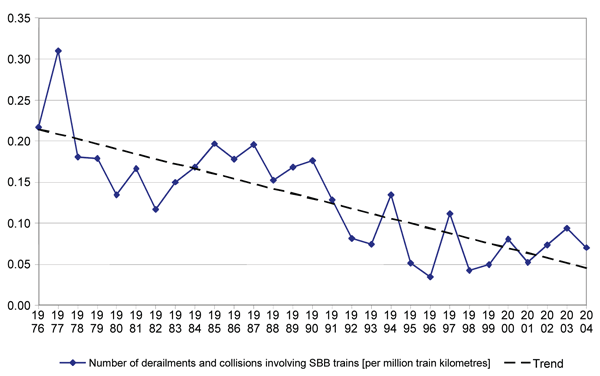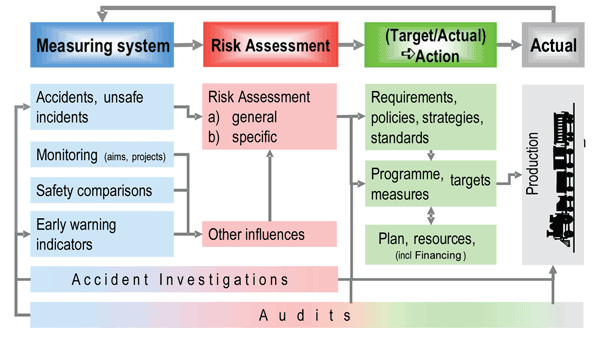Network safety – caring for the future
Posted: 14 February 2006 | | No comments yet
Network safety is an issue for both railway undertakings and infrastructure managers, not only with regard to ensuring railway safety but also with regard to establishing a manage-ment system that will guarantee safety remains affordable.
Network safety is an issue for both railway undertakings and infrastructure managers, not only with regard to ensuring railway safety but also with regard to establishing a manage-ment system that will guarantee safety remains affordable.
Network safety is an issue for both railway undertakings and infrastructure managers, not only with regard to ensuring railway safety but also with regard to establishing a manage-ment system that will guarantee safety remains affordable.
Railways have traditionally enjoyed a reputation as a highly safe means of transport. Furthermore, safety is one of the railways’ main selling points. The acknowledged high level of safety is being constantly improved. For instance, as Figure 1 indicates, SBB has, like many other railway companies, succeeded in consistently reducing the number of derailments and collisions per train kilometre despite greater traffic densities and rising speeds.
Nonetheless, the current wide-ranging debate on railway safety is probably the biggest ever in the industry’s history. In addition to various ongoing national approaches, in mid-2005 the European Railway Agency commenced far-reaching work on the specification of the safety management system prescribed by EU Directive 2004/49/EC. This has been triggered by railway reforms in various European countries involving a more or less strict separation of infrastructure managers (IM) and railway undertakings (RU). The business incentives associated with this organisational approach not only demand clear rules as regards responsibility for safety, but also rules on how to deal with reciprocal influencing of parameters that impact on safety.
Network safety, or similar concepts that focus on components of railway systems, are not very helpful on certain issues of railway safety management systems design. Network safety focuses on the safety of rail networks and is therefore strongly associated with infrastructure managers. Regardless of what network safety is taken to mean, it is only one part of the concept of railway safety.
The design of a safety management system focuses on the safety of the railway as a whole and not on parts of the railway. The primary interest is how to achieve the requisite level of safety as efficiently as possible. Separate treatment of the infrastructure manager will certainly not achieve this goal. Rather, an integrated approach is called for, aiming towards safety at the system level and involving both railway undertakings and infrastructure managers.
There are many examples to show that the requisite level of safety can only be attained with minimal outlay through careful coordination of infrastructural and rolling stock measures. Tunnel safety, for instance, primarily depends on not allowing trains that are on fire to enter tunnels, or on ensuring that trains can still get out of tunnels in the event of a fire. Even if one wishes to class tunnel safety as part of network safety, the main safety contribution still does not come from the infrastructure manager, but rather from the railway undertakings. The latter have to ensure that the rolling stock does not catch fire and that it has the necessary limp home properties. Only downstream, i.e. if a burning train comes to a standstill inside a tunnel, are safety measures dependent upon the rescue options, which are primarily influenced by the infrastructure manager.
Safety in the transportation of hazardous goods is also very highly dependent upon the interaction of infrastructure and rolling stock. Even if the infrastructure manager is directly responsible to the State as the owner of the facilities, the safety of hazardous goods transportation depends to a very high degree on the railway undertaking. The latter must, for instance, ensure that the correct rolling stock is used and that the goods are properly loaded and logged. Only in the context of an intervention, i.e. minimising the extent of accidents which have already happened, does the infrastructure manager play a substantial role.
Another important example is the measures in place to prevent trains passing signals at danger. Train control systems are systems intended for the railway as a whole and not just infrastructure managers or railway undertakings. These examples show that optimisation of system safety is a demanding business. The aim is to ensure that contributions to safety are shared among stakeholders in such a way as to yield the best possible result in both economic and business terms. In order to achieve this, one thing which is needed under all circumstances is an overarching safety management system; overarching in the sense that all the parties concerned are included in the system and will thus concentrate on achieving an optimal safety result. This task has always been performed by the railways. This kind of all-embracing safety management system must also be guaranteed in the future, regardless of the organisational forms which will underlie it.
At SBB, this task is safeguarded by the company’s integrated structure. The infrastructure and the majority of infrastructure users are all under the same management. Thus there is already an incentive at company level to design safety measures such that the requisite level of safety can be attained in the most advantageous way possible. This is why a safety management system covering all areas of the company has been implemented and is being operated under the leadership of the safety department, which reports directly to the CEO. The focus here is to ensure, in a risk-centred manner, that the requisite level of safety for the rail system is attained and that the measures taken in this regard are implemented with the best cost-benefit ratio. Individual interests of the infrastructure and traffic divisions are not the priority in the choice of measures.
The SBB safety management system is based on the principle that operational responsibility lies with the divisions (Infrastructure, Passenger Traffic, Cargo) and strategic responsibility with the Management Board. Corporate Safety manages the overarching safety management system process and supports SBB management in the area of company-wide safety management as well as the divisions, for which its main activities involve methodical issues.
The core of SBB’s safety management system is the safety management process (Figure 2).
SBB’s safety management process consists of the following three pillars and their subsystems:
- Comprehensive Measuring System
- Comprehensive Risk Assessment
- Comprehensive Safety Policies, Strategies and Safety Programmes
The essential aspect here is that all components of the safety management process are designed to cover all areas of the company.
The whole of SBB, including subsidiaries, is covered by a logging system for accidents, incidents and unsafe conditions. This means that management safety specifications and measured safety results are based on data from a single safety database used throughout SBB, which has practically created a standardised safety language and made regulation of safety issues substantially easier. The database provides comprehensive statistical statements on the safety level of the rail system.
A similar integral approach is also used in the assessment of safety risks. Once a year, all units involved in rail safety check the scope of the safety-relevant scenarios using a semiquanitative process and evaluate the need for future action. Input data include not only the findings from the measurement system, but all conceivable influencing factors, including the results of accident investigations and audits. Specific risk analysis is also consistently based on an integral approach; the systemic viewpoint is adhered to and the influences of RU and IM are always assessed. As the examples mentioned earlier show, in the case of tunnel safety or in the transportation of hazardous goods the most efficient solutions for SBB as a company and thus for the railway are sought, irrespective of the interests of the divisions involved.
The SBB safety management process also includes the management of soft factors. Assuming that a similar mindset on safety issues across all employees contributes heavily to safety culture, the occupational accident rate, for example, is an issue on company-level.
Furthermore, accidents with cross-divisional relevance for safety are also investigated centrally, likewise with the aim of implementing safety-related corrections in those places where action is possible and the most cost-efficient contribution will result.
The insights gained from accident logs, risk assessments, accident investigations and audits show up in safety policy and strategies, and above all in the safety programme. This programme is updated annually and contains all strategically relevant safety measures for SBB and thus for the rail system as a whole. The programme is a means of control for management. As well as safety projects, it contains strategically relevant safety parameters and objectives, via which the contributions of the divisions to safety are measured.
This kind of safety management system makes a substantial contribution to the railways’ long-term maintenance of the required level of safety and to making sure that this task is performed in the most cost-effective way possible. The SBB safety management system briefly outlined above has been developed in the context of an integrated enterprise. The processes institutionalised within it, however, have general validity for a rail system in which safety needs to be guaranteed in an efficient manner. Irrespective of how a railway is organised, the functionality of the system described above must be assured. An integrated enterprise constitutes an auspicious framework for an all-embracing safety management system. Management ensures that influence is exerted on the RU and IM, as the achievement of the best economic and business result is in the corporate interests of the enterprise.
The point is now to secure such a system for railways with other forms of organisation as well. Specifically, the designers of the new organisational forms must determine who should be in charge of the cross-system safety management process. Should the infrastructure managers take on this role? In this kind of case, the somewhat dubious term ‘network safety’ would have more than its commonly accepted meaning, and, as a term for system safety, would focus on the right issues. Should the State take over cross-divisional safety management? As safety issues affect a great number of railway aspects, this raises the following dilemma: on the one hand, attempts are in progress to denationalise the railway and at the same time to separate RU and IM; on the other, however, the finding of solutions to safety problems and thus the majority of production processes would be government-controlled.
Against this backdrop, if the railway is divided into infrastructure managers and railway undertakings, the challenging task will arise not only of guaranteeing the safety of the railway, but also of establishing a system under which safety will remain affordable for the railways in the future as well as today. The safety management process described in this article must, in principle, be implemented. It is to be hoped that the European Railway Agency will also take the absolutely central aspects of ‘safety with efficiency’ fully into account in its work on the shaping of the safety management framework required by the railways.


Figure 1: Number of derailments and collisions involving SBB trains


Figure 2: Safety management process of SBB AG







